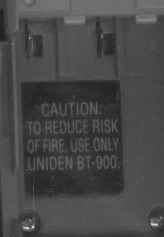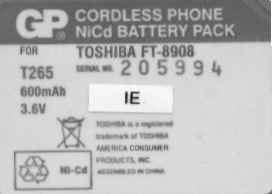Battery pack ripoff
Another example of commercial interests treating
customers as milch cows.
18 July 2003
The 600AA, it seems, is no longer manufactured. A quick search turned up
700mAh CADNICA AA cells at $8.98 for two and $15.95 for four (Australian
dollars, tax included). So the retail value of three cells is $11.9625 to
$13.47. Being generous about the case, the battery pack is worth at most
$14.00. With economies of scale, it should be possible to make decent
profits at $12.00.
From a consumer's point of view, Uniden's decision to employ this type
of battery pack (when ordinary AA NiCad cells would do the job nicely)
inflates the price by over 100% and reduces the value by two thirds: the
whole pack must be discarded when only one of three components has failed.
| The kicker is inside the battery compartment of
the handset:
Not my area of expertise, but:
- is there much fire risk in a 3.6 volt circuit?
- does the battery pack influence the risk?
|
 |
23 July 2003
Phoned Uniden in Sydney on (02) 9599 3355.
They confirmed that the BT-900 battery pack is not used in any current
Uniden product.
Their price? $40!
So the life of the product is effectively limited by how long the
battery packs continue in manufacture (and remain affordable).
26 July 2003
Reluctantly bought replacement from Tandy: the cheapest place in Cessnock
that had one in stock.
| The packaging reveals the brand that, I guess, Uniden reckons
will cause their handset to burst into flames: |
 |
| On the new battery pack, beneath a cheap sticker: |
 |
| Is another label: |
 |
At least I can still get replacements - for now.
Postscript
After cleaning up components of the old battery pack, I now have two
perfectly serviceable AA Nickle Cadmium rechargeable cells.
